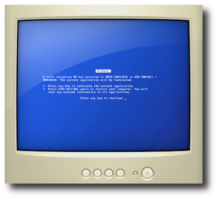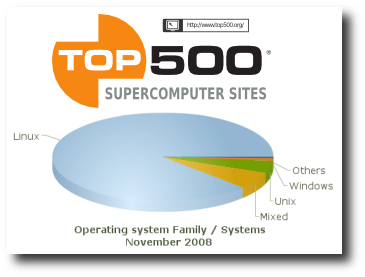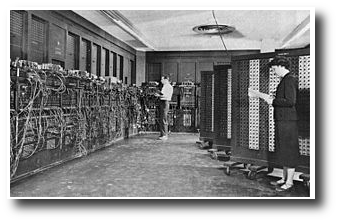 In 1947, while troubleshooting a "new" computer, Lieutenant Grace Murray Hopper discovered a moth in the machine. She removed it, taped it to her log book, and made history with the note: "first actual case of bug being found".
In 1947, while troubleshooting a "new" computer, Lieutenant Grace Murray Hopper discovered a moth in the machine. She removed it, taped it to her log book, and made history with the note: "first actual case of bug being found".
ENIAC did not run for more than five days at a time before one of its 18,000 vacuum tubes burned out. Later, transistors and integrated circuits would enable computers to run for years without a breakdown. 
The "bugs" that affect modern users are not mechanical failures, but rather subtle flaws in operating system and application software. During the rise of personal computers, users became so accustomed to fixing problems by restarting their systems that a special 3-key sequence (Ctrl-Alt-Del) was created for that purpose. 
Microsoft users continue to be plagued with the infamous "Blue Screen of Death", such as the one broadcast to hundreds of millions of viewers around the world during the opening of the 2008 Beijing Olympics.
Unlike personal computers, which are operated by a single person for a few hours a day, supercomputers have thousands of users and must operate flawlessly, around the clock, sometimes working on a single problem for months at a time.
 Over 87% of the top 500 fastest supercomputers in the world use Linux for their operating system, including the most powerful supercomputer in the world, the "Roadrunner" at Los Alamos National Laboratories. When it comes down to speed and reliability, there is no contest, Linux is the number one choice. Linux drives the New York Stock Exchange (NYSE), Google, and Amazon.com, and is freely available for organizations of any size.
Over 87% of the top 500 fastest supercomputers in the world use Linux for their operating system, including the most powerful supercomputer in the world, the "Roadrunner" at Los Alamos National Laboratories. When it comes down to speed and reliability, there is no contest, Linux is the number one choice. Linux drives the New York Stock Exchange (NYSE), Google, and Amazon.com, and is freely available for organizations of any size.
 Remarkable advances in technology continue to make computers smaller, cheaper, and more powerful.
Remarkable advances in technology continue to make computers smaller, cheaper, and more powerful.
Sixty years ago, ENIAC, the first general-purpose electronic computer weighed 27 tons and cost the equivalent of $4,000,000.
The iPod shuffle™ is several thousand times more powerful, has one million times the storage capacity, and you can wear one today for less than $100.
A similar revolution is taking place in computer software. The Internet has virtually eliminated the cost of software distribution and promotes world-wide collaboration of software development and testing. The Open Source philosophy drives thousands of software projects, including operating systems, software development tools, languages, web servers, database servers, search engines, VOIP, network security solutions, office applications, and multi-media design tools, mostly free for the asking. 
If you use the Internet, you are using Open Source Software. Companies like Google and Amazon.com are extremely successful in leveraging the power of Open Source, building successful business applications without the expense of software licensing fees. These companies, and thousands more, pay only for the services they need to complement their internal resources.
Anteil, Inc. has been working with the technology that drives the Internet for over 25 years and is proud to offer a full range of IT services to help you leverage the power of the Internet and Open Source Software to achieve your goals, reduce your operating costs, and gain visibility and control of your digital communications. Please give us a call at (717) 671-1141 for a no-cost, professional evaluation of your technology plans.